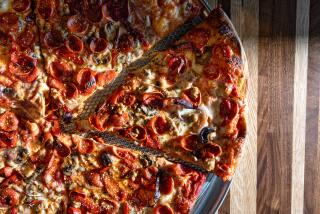The Great Debate: Thick Versus Thin
- Share via
There are two kinds of people in the world: those who understand that the only pizza worth eating comes on a thin, crisp crust--and those who have no taste at all.
Pizza has gotten snooty in recent years, but when I was growing up, pizza was the people’s food. You found it in good bars, in bowling alleys--and in little joints where you bought it by the slice. (If you were smart, you never bought anything by the slice unless you showed up just as a fresh hot pie was coming out of the oven.) Then you burned the roof of your mouth taking the first bite.
If you were really lucky you had an Italian friend whose mother made pizza. Like Robert Bergamini, who was in my third-, fourth- and fifth-grade classes, and whose birthdays we looked forward to with unrestrained enthusiasm. Mrs. Bergamini actually baked pizza for Robert’s birthday parties, and it was just about the most delicious thing that any of us could imagine eating. Her crusts were paper-thin--and really crisp--and they were topped with fresh tomatoes, and fresh basil, and really good cheese. Eating it made me wish that I had been born in Italy.
In those days, New York had a few pathetic places that produced an aberration called “thick-crust pizza,” but nobody actually ate the stuff. When you bit in, your teeth just kept sinking in a most unpleasant way; it was sort of like eating pizza made of Wonder Bread. All the grease from the sauce and the cheese got absorbed by the crust, and what you ended up with was a sort of tomato-cheese ball.
How could people eat that stuff, I wondered? Didn’t they understand that the beauty of pizza wasn’t just how delicious it tasted, but also the textural dance of the dish? The whole point of pizza, to my way of thinking, is the play of stringy cheese and slick sauce against the crispness of the crust. As far as I’m concerned, pizza on a thick crust is just a pathetic tomato-and-cheese sandwich. If what you want is bread, why not order it?
More to Read
Eat your way across L.A.
Get our weekly Tasting Notes newsletter for reviews, news and more.
You may occasionally receive promotional content from the Los Angeles Times.










